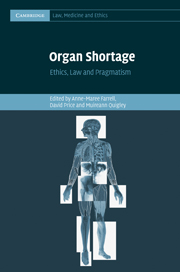Book contents
- Frontmatter
- Contents
- List of figures
- List of tables
- Contributors
- Acknowledgements
- List of abbreviations
- Table of cases
- Table of legislation
- Part I Setting the scene
- Part II Current issues affecting organ shortage
- Part III Strategies for addressing organ shortage
- Part IV Comparative perspectives
- 10 Institutional organisation and transplanting the ‘Spanish Model’
- 11 Kidney donation: lessons from the Nordic countries
- 12 Organ donation and transplantation: the Canadian experience
- 13 Systematic increases in organ donation: the United States experience
- Part V Current reform and future challenges
- Bibliography
- Index
13 - Systematic increases in organ donation: the United States experience
from Part IV - Comparative perspectives
Published online by Cambridge University Press: 29 March 2011
- Frontmatter
- Contents
- List of figures
- List of tables
- Contributors
- Acknowledgements
- List of abbreviations
- Table of cases
- Table of legislation
- Part I Setting the scene
- Part II Current issues affecting organ shortage
- Part III Strategies for addressing organ shortage
- Part IV Comparative perspectives
- 10 Institutional organisation and transplanting the ‘Spanish Model’
- 11 Kidney donation: lessons from the Nordic countries
- 12 Organ donation and transplantation: the Canadian experience
- 13 Systematic increases in organ donation: the United States experience
- Part V Current reform and future challenges
- Bibliography
- Index
Summary
The demand for organ transplantation outstrips the supply of donated organs by a high margin in the United States (USA). As of December 2009, there were over 105,000 Americans awaiting an organ transplant and approximately 18 people per day dying whilst waiting. This public-health crisis is being addressed in the USA on several fronts, including significant changes in the laws governing consent to donation, as well as in organ donation practices. As a result, organ donation in the USA has gone through a remarkable transformation: there was a 30 per cent increase in the total number of organs donated for transplant between 2004 and 2009, contrasting with the previous decade which experienced an average increase per year of only 1–2 per cent. Although a confluence of factors, including changes in the law and practice of donation, have contributed to this outcome, it is the federal-government-sponsored ‘Breakthrough Collaborative’ initiative which is credited with stimulating the change. This initiative, designed with a clear intent to increase organ donation for transplantation, is derived from process-improvement principles and has produced measurable results.
This chapter examines best practices which have emerged from the initiative, as well as developments in the law and process that have improved rates of organ donation in the USA. In particular, consideration is given to how these changes have led to an increase in the potential pool of donors through donation after cardiac death protocols, innovative living donor programmes and increased rates of consent through more effective opt-in donation laws.
- Type
- Chapter
- Information
- Organ ShortageEthics, Law and Pragmatism, pp. 195 - 212Publisher: Cambridge University PressPrint publication year: 2011
- 1
- Cited by



